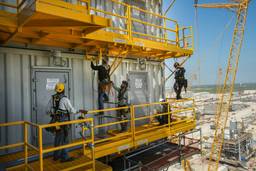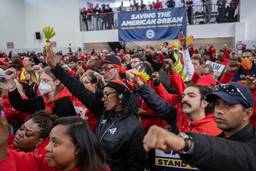
CHICAGO — Alejandro waits eagle-eyed on the street corner with the other day laborers. He has three small white pills in his pocket, a few dollars and a heart full of hope that he’ll earn something today.
He needs the pills to kills the pain in his back, the pain that he has suffered since falling off a ladder doing some siding work a few weeks ago. He figures he fell about two stories after the ladder fell away from the building. He tumbled downward and hit a concrete alleyway where he was working.
He hasn’t worked since he was injured, but today he feels better, so he waits on the corner at Belmont and Milwaukee avenues with dozens of other men. Poles, Russians, and other Eastern Europe men on one side. Latinos on the other.
Alejandro is also here because he badly needs some money. There have been days lately when he has less than $10 to go around for him and his wife and two young children, ages 11 and two years old.
He went to a worker’s compensation lawyer after his injury and the lawyer sent him to a doctor and the doctor treated but then stopped helping him, saying he wasn’t sure if Alejandro would be able to pay him, he explains.
So Alejandro went to the large county hospital near downtown Chicago where he waited hours for the pain medicine.
The contractor who hired him off the street where the day laborers or jornaleros gather didn’t offer to pay for his injury, he says, and he doesn’t know much about him. All he knows is a telephone number he scribbled down from a sticker that he saw the contractor paste onto equipment.
Before he was injured, things were bad enough. There was little work in the summer and not much after that. Until he was injured, he would work one or two days a week, earning $80 for an eight-hour day. Unlike some of the others, he tries to stick to the $10 an hour rate that the men had settled on. But nowadays it is hard to stick to that rate when hungry workers will take $7 an hour and sometimes $6.
A few feet away a roofing contractor pulls up in a truck and a dozen men wildly dash towards him and plead for him to hire them. Three leap into the truck cab next to him and they quickly pull out.
Eric Rodriguez, director of the Latino Union of Chicago, a small agency that helps the day laborers, eyes the crowd scene and shakes his head.
The lack of work, he says, is forcing the men to go against their vows to stick to $10 an hour, a bottom line rate that the men had been trying to abide by. The Latinos and Eastern Europeans recently met with the help of Rodriguez’s organization and they said they would stand firm on the rate. But hard times top street corner solidarity.
“The sad thing is that there was no work spring and summer and now winter is here,” Rodriguez says. “And the contractors are offering them less and sometimes not paying them at all.”
He knows of another man on the corner, who, like Alejandro, injured himself in a fall. He too doesn’t have insurance and can barely afford the medicine. “So he has to keep injecting himself with painkiller to make sure he can keep working,” Rodriguez says.
Alejandro talks with Rodriguez and learns of a lawyer who helps injured day laborers like himself and who the Latino Union has great faith in. Like some of the men on the corner, Alejandro has also thought about going home to Mexico, home after 15 years of living in the U.S. without papers.
“I think about going back. But without money and no house, it doesn’t make sense,” he says in Spanish with a shrug of shoulders and a frown.
He came from far on Chicago’s South Side to the street corner here in the Northwest Chicago community before the sun came up because he thought there would be work. But there isn’t. Most of the men are still waiting at 9 a.m. when they should have been already hired.
So Alejandro waits eagle-eyed on the street corner. He is a tall, thin man in his late 30s who doesn’t look strong like some of the others on the street corner do.
The men barely talk to each other. Instead, they patiently watch the street, looking for trucks or cars that pull up so they can pounce on them before the other day laborers do. His jacket is too thin for the cold morning air so he shivers a little.
It’s a thick silence.
He has three small white pain pills in his pocket — the last ones he has left — a few dollars and a heart full of hope.
Editor’s note: Alejandro’s last name has been withheld from this story to protect his identity.
A former labor writer for the Chicago Tribune, Stephen Franklin is a Pulitzer Prize finalist and an adjunct professor at the University of Illinois Urbana-Champaign School of Labor and Employment Relations.







